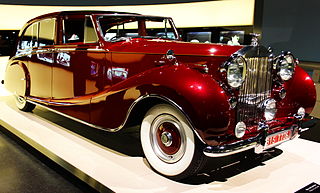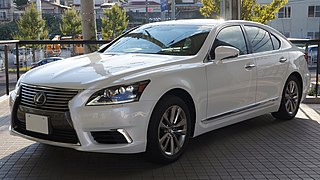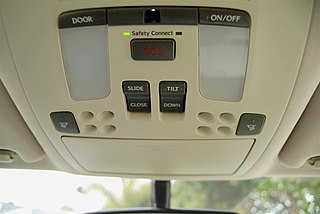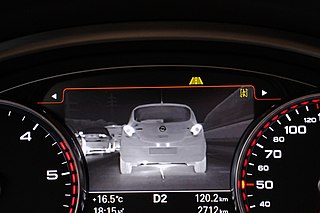
Lexus is the luxury vehicle division of the Japanese automaker Toyota. The Lexus brand is marketed in more than 70 countries and territories worldwide and is Japan's largest-selling make of premium cars. It has ranked among the 10 largest Japanese global brands in market value. Lexus is headquartered in Nagoya, Japan. Operational centers are located in Brussels, Belgium, and Plano, Texas, United States.

A luxury car is a car that provides increased levels of comfort, equipment, amenities, quality, performance, and status relative to regular cars for an increased price.

Electronic stability control (ESC), also referred to as electronic stability program (ESP) or dynamic stability control (DSC), is a computerized technology that improves a vehicle's stability by detecting and reducing loss of traction (skidding). When ESC detects loss of steering control, it automatically applies the brakes to help steer the vehicle where the driver intends to go. Braking is automatically applied to wheels individually, such as the outer front wheel to counter oversteer, or the inner rear wheel to counter understeer. Some ESC systems also reduce engine power until control is regained. ESC does not improve a vehicle's cornering performance; instead, it helps reduce the chance of the driver losing control of the vehicle.

The Lexus GS is an executive car sold by Lexus, the premium division of Toyota. The same car had been launched in 1991 as the Toyota Aristo in Japan. For non-Japanese markets, it was release as the Lexus GS in February 1993. It continued using the Toyota Aristo name for the Japanese market until January 2005.

The Lexus LS is a full-size luxury sedan serving as the flagship model of Lexus, the luxury division of Toyota. For the first four generations, all LS models featured V8 engines and were predominantly rear-wheel-drive. In the fourth generation, Lexus offered all-wheel-drive, hybrid, and long-wheelbase variants. The fifth generation changed to using a V6 engine with no V8 option, and only one length was offered.

Advanced driver-assistance systems (ADAS) are electronic systems that assist drivers in driving and parking functions. Through a safe human-machine interface, ADAS increase car and road safety. ADAS systems use automated technology, such as sensors and cameras, to detect nearby obstacles or driver errors, and respond accordingly.

In road-transport terminology, a lane departure warning system (LDWS) is a mechanism designed to warn the driver when the vehicle begins to move out of its lane on freeways and arterial roads. These systems are designed to minimize accidents by addressing the main causes of collisions: driver error, distractions and drowsiness. In 2009 the U.S. National Highway Traffic Safety Administration (NHTSA) began studying whether to mandate lane departure warning systems and frontal collision warning systems on automobiles.

Automatic parking is an autonomous car-maneuvering system that moves a vehicle from a traffic lane into a parking spot to perform parallel, perpendicular, or angle parking. The automatic parking system aims to enhance the comfort and safety of driving in constrained environments where much attention and experience is required to steer the car. The parking maneuver is achieved by means of coordinated control of the steering angle and speed which takes into account the actual situation in the environment to ensure collision-free motion within the available space.

The Toyota Brevis is a former mid-size luxury sedan introduced in May 2001, that was sold only in Japan.

Adaptive cruise control (ACC) is an available cruise control advanced driver-assistance system for road vehicles that automatically adjusts the vehicle speed to maintain a safe distance from vehicles ahead. As of 2019, it is also called by 20 unique names that describe that basic functionality. This is also known as Dynamic cruise control.

The D-segment is the 4th category of the European segments for passenger cars, and is described as "large cars".
An official state car is a vehicle used by a government to transport its head of state or head of government in an official capacity, which may also be used occasionally to transport other members of the government or visiting dignitaries from other countries. A few countries bring their own official state car for state visits to other countries, for instance, the United States, Russia, the United Kingdom, South Korea, Germany and Japan. It also may serve as an automotive symbol of the head of state and their country. An official state car must have adequate security, capability and stateliness for its duty. A limousine, F-segment, luxury car or executive car is usually selected.

A collision avoidance system (CAS), also known as a pre-crash system, forward collision warning system, or collision mitigation system, is an advanced driver-assistance system designed to prevent or reduce the severity of a collision. In its basic form, a forward collision warning system monitors a vehicle's speed, the speed of the vehicle in front of it, and the distance between the vehicles, so that it can provide a warning to the driver if the vehicles get too close, potentially helping to avoid a crash. Various technologies and sensors that are used include radar (all-weather) and sometimes laser (LIDAR) and cameras to detect an imminent crash. GPS sensors can detect fixed dangers such as approaching stop signs through a location database. Pedestrian detection can also be a feature of these types of systems.

The Lexus LS (XF40) is the fourth generation of the Lexus LS line of full-size luxury sedans. Lexus debuted the model line at the 2006 North American International Auto Show, with variants including the standard wheelbase LS 460 (USF40) and long wheelbase LS 460 L (USF41); the chassis codes (USF40/USF41) are derived from the fourth generation XF40 platform code and UR series engine designation. In development from 2001, the final design was selected for the V8 models in late 2003, with the hybrid variant's design finalized in 2004. Introduced at the 2006 New York International Auto Show, all-wheel drive hybrid models, the standard wheelbase LS 600h (UVF45) and long wheelbase LS 600h L (UVF46), joined the lineup in the 2008 model year. The LS 460 and LS 460 L models feature a 4.6 L UR series V8 and an 8-speed automatic transmission, while hybrid models are powered by a 5.0 L UR series V8 engine equipped with electric motors, with a continuously variable transmission and all-wheel drive. All-wheel drive versions of the non-hybrid LS 460 (USF45) and LS 460 L (USF46) models were introduced at the 2008 Moscow International Automobile Salon. The XF40 received updates for the 2010 and 2013 model years.

Safety Connect is a subscription-based telematics system introduced by Toyota Motor Corporation in 2009 for its Toyota-branded and Lexus models. The system provides communications, roadside assistance, car safety, remote diagnostics, and other services. Unlike the earlier Lexus Link service offered on Lexus models, the Safety Connect system is proprietary and not licensed from GM's OnStar service. Safety Connect began to be offered on vehicles in the middle of 2009. For Toyota vehicles, the Safety Connect service is offered including the aforementioned features as part of the Toyota Entune telematics package, while Lexus models receive the Lexus Enform telematics system with Safety Connect, adding hands free calling, and destination assistance services.

An automotive night vision system uses a thermographic camera to increase a driver's perception and seeing distance in darkness or poor weather beyond the reach of the vehicle's headlights. Such systems are offered as optional equipment on certain premium vehicles. The technology was first introduced in the year 2000 on the Cadillac Deville. This technology is based on the night vision devices (NVD), which generally denotes any electronically enhanced optical devices operate in three modes: image enhancement, thermal imaging, and active illumination. The automotive night vision system is a combination of NVDs such as infrared cameras, GPS, Lidar, and Radar, among others to sense and detect objects.

Vehicle Dynamics Integrated Management (VDIM) is an integrated vehicle handling and software control system developed by Toyota. It involves an omnibus computer linkage of traction control, electronic stability control, electronic steering, and other systems, with the intent of improving responsiveness to driver input, performance, and overall safety. The system was first introduced in the Japanese domestic market in July 2004, when Toyota debuted VDIM on the Toyota Crown Majesta. This was followed by the VDIM's export debut on the third generation Lexus GS, which was launched in 2005. VDIM integrates the company's Electronically Controlled Brake (ECB), Anti-Lock Brakes (ABS), Electronic Brakeforce Distribution (EBD), Traction Control (TRC) and Vehicle Stability Control (VSC) active safety systems with the Adaptive Variable Suspension (AVS), Electric Power Steering (EPS) and Variable Gear Ratio Steering (VGRS) systems which previously worked independently using proprietary software. This way all the systems function together rather than the ECU prioritizing which is the most important. VDIM was initially designed for rear-wheel drive cars.
Driver drowsiness detection is a car safety technology which helps prevent accidents caused by the driver getting drowsy. Various studies have suggested that around 20% of all road accidents are fatigue-related, up to 50% on certain roads.
A connected car is a car that can communicate bidirectionally with other systems outside of the car (LAN). This allows the car to share internet access, and hence data, with other devices both inside and outside the vehicle. For safety-critical applications, it is anticipated that cars will also be connected using dedicated short-range communications (DSRC) or cellular radios, operating in the FCC-granted 5.9 GHz band with very low latency.

In road-transport terminology, lane centering, also known as auto steer or autosteer, is an advanced driver-assistance system that keeps a road vehicle centered in the lane, relieving the driver of the task of steering. Lane centering is similar to lane departure warning, but rather than warn the driver, or bouncing the car away from the lane edge, it keeps the car centered in the lane. Together with adaptive cruise control (ACC), this feature may allow unassisted driving for some length of time.
















